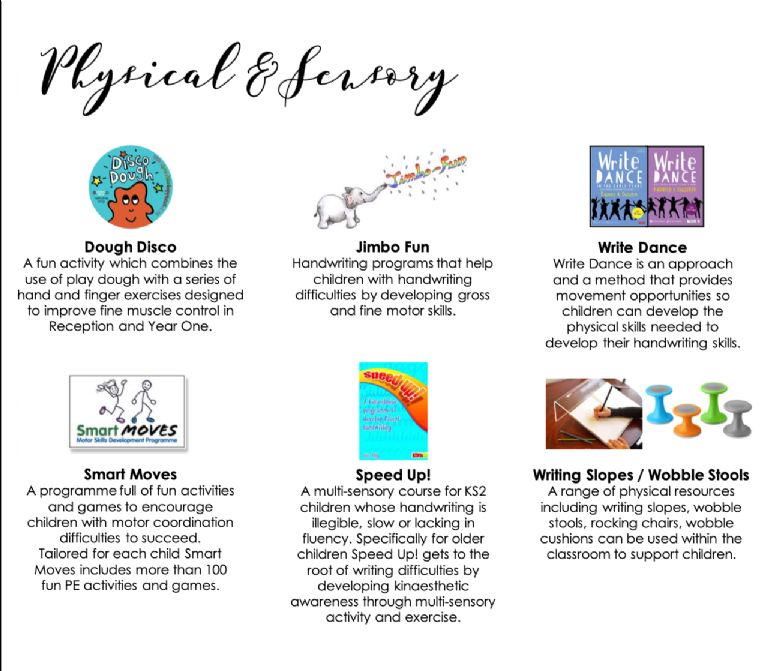Physical and Sensory
What is Physical and Sensory?
The Occupational therapy service work with children who have difficulties which can prevent access to the learning environment. Children may have a physical disability or diagnosis such as Autism Spectrum Disorder, Developmental Coordination Disorder or Sensory Processing Dysfunction.
Occupational Therapy support the development of functional skills including fine motor skills, gross motor skills, visual perception and self-care.
- Fine motor skills involve the coordination of small muscle movements within the hands and fingers. We need these skills to help us participate in classroom activities such as play, handwriting, use of scissors or tools and self-care.
- Gross motor skills involve the movement and coordination of the arms, legs, and other large body parts which are needed for participation in PE, play and participation in classroom activities.
- Visual perception is the ability to use visual information to recognise, recall, discriminate and make sense of what we see. For example, it is important for the guidance of movement when writing and catching a ball. Visual perception is learnt through touch, movement and vision.
- Self-care refers to activities of daily living such as dressing ourselves, feeding, drinking and toileting. Some children need support to develop their independence with these skills.
Some children have difficulty with sensory processing. Sensory processing is our ability to receive, process and respond to sensory input from the environment around us. It involves the use of our senses including visual, auditory, smell, taste, touch, proprioception (body awareness) and vestibular (movement). Difficulty with sensory processing can impact attention and concentration, motor control and emotional/behavioural responses. OT will support with the assessment of these skills and provision of intervention or strategies
How do we support this?
At Bengeworth we adopt the following strategies and interventions to provide challenge and additional opportunity for our pupils with physical and sensory needs:
High Quality Teaching:
The pupils needs can be met in the classroom through every day high quality teaching which can include considerations of the classroom environment. Important aspects that our teachers will consider are seating and positioning, sensory strategies and ensuring that learning resources are accessible.
Targeted / Individualised Support:

What can you do at home?
If you think your child might need help with their physical skills at home you can support them in the following ways:
- Playing a variety of games that require co-ordination, balance, and ball skills e.g. catching and throwing, target practice, obstacle courses and swimming.
- Encouraging your child to be physically active and engage in sports outside of school.
- Playing with small toys and objects that can manipulate e.g. shape posting box, using scissors for arts and crafts, jigsaw puzzles, playdough.
Further sensory or physical advice can be sought from the Occupational Therapist according to your child’s needs.
Useful links
National Autistic Society - Explains the different types of sensory difficulties some children with Autism may encounter and how to support them:
http://www.autism.org.uk/sensory
Here is another link on the different types of sensory difficulties and examples of support:
https://www.iidc.indiana.edu/pages/Sensory-Integration-Tips-to-Consider
- CDC (Council For Disabled Children)
